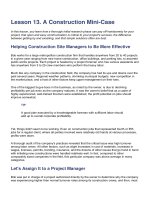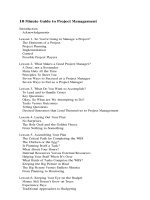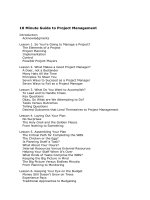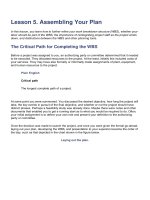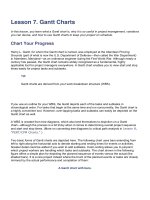ENGINEERS GUIDE TO CALIBRATION MANAGEMENT pptx
Bạn đang xem bản rút gọn của tài liệu. Xem và tải ngay bản đầy đủ của tài liệu tại đây (99.78 KB, 19 trang )
ENGINEERS
GUIDE
TO
CALIBRATION
MANAGEMENT
A Four step guide to Calibration Management.
By Patrick Fogwill
A Metrology Solutions (Melbourne) Publication
Engineers Guide to Calibration Management – Pat Fogwill (c) 2011
ii
Published in Australia in 2011 by
Metrology Solutions (Melbourne)
2 / 173 Albert Avenue, Boronia, Victoria. 3155. Australia.
(c) Patrick Fogwill
2011
This publication may be transmitted in any form, by any means electronically
or mechanically, including photocopying, recorded or any information storage
or retrieval system.
Distributed by; Metrology Solutions (Melbourne).
Engineers Guide to Calibration Management – Pat Fogwill (c) 2011
iii
DISCLAIMER OF LIABILTY.
The ENGINEERS GUIDE TO CALIBRATION MANAGEMENT written from the experience of
many years in the manufacturing and service industries and has been published as an aid
for those who wish to maintain or develope a calibration management system.
The Author, the publisher, and the printers accept no liability for the results of actions and
decisions taken by anyone from reading this publication.
Engineers Guide to Calibration Management – Pat Fogwill (c) 2011
1
Contents:
1. Quality Document System 2
1.1 User Requirement 3
1.2 Design Qualification 3
1.3 Installation Qualification. 4
2. Defining the measurement criteria 5
2.1 Defining the limits of accuracy 5
2.2 Set the “Calibration Factor” 5
2.3 Set the instrument “As Found Limit” 5
2.4 Set the instrument “As Left Limit” 5
2.5 Set the “Calibration Frequency” 5
3. Calibration Support Documents 6
3.1 Calibration Master List. 6
3.2 Calibration Process Flow Diagram. 7
3.3 Equipment Labelling 8
3.4 Calibration Reports 9
3.5 Calibration Deviation Control: 12
3.6 Calibration Change Request 13
3.7 Calibration Operation Procedure 14
3.8 Calibration Training Documentation 15
4 Your own Calibration Management System. 16
Engineers Guide to Calibration Management – Pat Fogwill (c) 2011
2
1. Quality Document System
Planning: Prepare a written validation document
Specifications: Specify what is required and agree the content, using:
User Requirement.
Design Qualification.
Test Planning: Document how the equipment is to be tested, using:
Operational Qualification.
Installation Qualification.
Performance Qualification.
Testing: Perform tests and record results, and update:
Operational Qualification.
Installation Qualification.
Performance Qualification.
Review: Review results for system performance and conformity to:
User Requirement.
Design Qualification.
Start here
Check
Performance
Qualification
User
Requirement
check
Operational
Qualification
Design
Qualification
check
Installation
Qualification
System Build
Diagram of the “V” Model.
Engineers Guide to Calibration Management – Pat Fogwill (c) 2011
3
1.1 User Requirement. The User Requirement defines the basic process
requirements to produce a product. The details are:
U.R. table:
Process/Line Description Discipline Eng. Unit Range Accuracy
1a/1 Dispensing Mass g 10 - 500 100mg
This document should be dated with the approval signatories of the
User/Owner and Quality Assurance management, and should be version
controlled.
1.2 Design Qualification. From the “User Requirements” the “Design
Qualification” is engineered. A description of process with the requirement
details of the measuring equipment, as:
D.Q. table:
Process and line number
1a/1
Description
Dispensing
Discipline
Mass
Eng. Unit
g
Range of process
10g - 100g
Criticality: 1 Product, 2 Process, 3 Safety, 4 Other
1
Precision
1%
Resolution of process
100mg
Resolution of measurement
1mg
Calibration Factor
4
As Found Limit
25mg
As Left Limit
6mg
Highlighted figures in the above table are calculated as explained below:
Calculations:
Precision: = Regulatory = 1%
Process minimum = 10g
Resolution of process: = Process Min. x Precision = 100mg
Resolution of measurement: = Res. of process / 100 = 1mg
Calibration Factor: = 4
As Found Limit: = Res. of process / Calibration Factor = 25mg
As Left Limit: = As Found Limit / Calibration Factor = 6mg
Highlighted figures in the above are used in the D.Q. table.
This document should be dated with the approval signatories of the User/owner,
Engineering management and Quality Assurance management, and should be version
controlled.
Engineers Guide to Calibration Management – Pat Fogwill (c) 2011
4
1.3 Installation Qualification. From the “Design Qualification” the “Installation
Qualification” describes the process and the equipment details specified, as:
Equipment Identity Number
Description of Equipment
The measurement discipline
The measurement engineering unit
The range of equipment
The resolution of equipment
The accuracy of the equipment
Make of equipment
Model of equipment
Serial Number of equipment
The criticality: 1 Product, 2 Process, 3 Safety 4 Other
The precision
Process minimum
Calibration factor
As found Limit
As Left Limit
Operating procedure document number
Who Calibrates
Calibration period
This document should be dated with the approval signatories of the User/owner, Engineering
management and Quality Assurance management, and should be version controlled.
Engineers Guide to Calibration Management – Pat Fogwill (c) 2011
5
2. Defining the measurement criteria.
Process.
Product.
Health & Safety.
The documents used for these details are:-
User requirements.
Design qualifications.
Installation qualifications.
Calibration master lists.
Operation procedures.
2.1 Defining the limits of accuracy for all measuring instruments. The limits of
measurement must be better than the required limits for the product, process
and safety. If the measuring instrument fails to meet calibration limits then the
product, process or safety could have been compromised. If a factor of two is
set, and if the measuring instrument fails calibration there is a margin allowed
before any quality issues are raised. The factor should be as large as possible,
the larger the factor the greater the safety margin. The setting of the factor
often depends upon the repeatability of reading and the errors found during
calibration. This factor is called the “Calibration Factor” and is applied to many
stages in the calibration maintenance process.
2.2 Set the “Calibration Factor”. The ideal “Calibration Factor” is four,
Example: if the product measurement criterion is 100g +/- 1g, then the limit for
measurement is 1g / 4, (100g +/- 250mg).
2.3 Set the instrument “As Found Limit”. As defined in section 2.2.
Example: 250mg.
2.4 Set the instrument “As Left Limit”. Using the “Calibration Factor” of four, the
“As Left Limit’ is defined as: “As Found Limit”/4. (62.5mg).
2.5 Set the “Calibration Frequency” (the period between calibrations). The
“Calibration Frequency” can only be set by having knowledge of the data
collated during calibrations; also consideration must be given to the
environment where the instrument is used. The results of many calibrations can
determine the period of calibration; the period is set given the criteria that the
worst case “As Found result” is equal to or less than the “As Found Limit” at the
end of the period. Experience has found that the best unit for calibration
frequencies is days, weeks, i.e.; Days (1 thru 7), Weeks (1, 2, 4, 13, 26, 52,104
and so on). When adjusting the calibration period, consider extending by 1 step
at a time, or reducing by at least 2 steps at a time.
Note: Check and update the data in the documents:
User requirements.
Design qualifications.
Installation qualifications.
Calibration master lists.
Operation procedures.
Engineers Guide to Calibration Management – Pat Fogwill (c) 2011
6
3. Calibration Support Documents
3.1 Calibration Master List.
From the “Installation Qualification” the detail for the “Master Calibration List”
is defined, and the equipment details are:
Location: Building/Department/Line Number
Equipment Identity Number
Description of Equipment
The measurement discipline
The measurement engineering unit
The range of equipment
The resolution of equipment
The accuracy of the equipment
Make of equipment
Model of equipment
Serial Number of equipment
The criticality: 1 Product, 2 Process, 3 Safety, 4 Other
The precision
Process minimum
Calibration Factor
As found Limit
As Left Limit
Operating procedure document number
Who Calibrates
Calibration period
This document should be dated with the approval signatories of the User/owner, Engineering
management and Quality Assurance management, and should be version controlled.
Engineers Guide to Calibration Management – Pat Fogwill (c) 2011
7
3.2 Calibration Process Flow Diagram.
Start
Calibration
job obsolete
Work order issued
Calibration job
overdue
Enter “Job Obsolete”
on report
Follow procedures
Operation
Procedure.
Raise Deviation
report
Sign off report
As Found test
Fail
Label as Do Not Use
Raise Deviation
report
Enter AF results on
report
Enter AF results on
report
Raise Deviation
report
Label “Do Not Use”
As Left test
Fail
Adjust
Pass
As Left test
Fail
Adjust
Pass
As Left test
Fail
Adjust
Pass
As Left test
Fail
Enter AL results on
report
Enter AL results on
report
Raise Deviation
report
Sign off report
Sign off report
Label “Do Not Use”
Label “Calibrated”
Check equipment
report
Changes required
Raise Change
request
Frequency
Limits
Operation Procedure
Check & approve
File report
Engineers Guide to Calibration Management – Pat Fogwill (c) 2011
8
3.3 Equipment Labelling. All equipment that is defined as critical must be
identified using a label attached to the equipment. The label to indicate:
Owner Company.
Location: Department/Line.
Equipment Identity Number.
Equipment Criticality.
Equipment Description.
All critical measuring equipment must have a calibration status label attached
indicating:
Equipment Identity Number.
When Calibrated.
Calibration next due.
Who calibrates. (Name of responsible person or contracting organisation).
The above criteria are best contained in a single clear label holder, below shows
a template for the labels, where the calibration label is positioned at the bottom
of the equipment identity label within the holder.
Equipment Owner
Location: Dept / Line
Equipment Identity Number
Criticality
Description
DO NOT USE
Equipment Identity Number
When Calibrated
Calibration Next Due
Who Calibrates
CALIBRATED
Engineers Guide to Calibration Management – Pat Fogwill (c) 2011
9
3.4 Calibration Reports
Calibration Report
Page
<#>
/
<#>
Equipment I.D. #
Work Order #
Date
SOP
Description
Department
Location
Equipment used:
Equipment I.D.#
Description
As Found Results:
Warm up time
Confirmed
Reference Value
DUT value
Error
Limit
Pass/Fail
Engineers Guide to Calibration Management – Pat Fogwill (c) 2011
10
Calibration Report
Equipment I.D
Work Order #
Date
Page
<#>/<#>
As Left Results
Warm up time
confirmed
Reference Value
DUT value
Error
Limit
Pass/Fail
Comments:
Calibra
ted By:
Date:
Checked By:
Date:
This document should be version controlled, ideally as a part of an Operation Procedure.
Engineers Guide to Calibration Management – Pat Fogwill (c) 2011
11
Calibration Report – Support Documents.
Some calibration reports may be from external contractors. Some of these may
not show the Pass/Fail status based to your limits. You will be required to
generate calibration support documents to show the equipment calibration
status based upon your limits. Below is an example of support documentation
for a particle counter:
Data from the calibration report:
Comparator thresholds
Range uM
Analogue Values
Initial mV
Final mV
0.5
121
129
Particle Response
Nominal
uM
Particle data
Median Response
GMD
uM
Lot # U uM
Initial
mV
Final
mV
Sensitivity
uM/V
0.5
0.499
1234567
0.005
129
129
3.8
7
The above table shows that the report findings report errors in mV.
The applied limits for the particle size errors should use the engineering unit of
uM; therefore, a new table is required that calculates the errors in uM using the
data in the contractor calibration report.
Generated table for conversion of mV results to uM.
Calculated errors in uM from data in the calibration report
Applied Limits
Initial
sensitivity
uM /mV
Final
sensitivity
uM/mV
Initial
Counter
response
uM
Final
Counter
Respons
e uM
Initial
Error
uM
Final
Error
uM
Initial
+/- uM
Final
+/- uM
0.025
0.006
0.003868
0.003868
0.468
0.499
0.031
0
The calculations used in the table above:
Initial Sensitivity: GMD particle size / Initial Median Response.
Final Sensitivity: GMD particle size / Final Median Response.
Initial Counter Response: Initial sensitivity x Initial comparator response.
Final Counter Response: Final sensitivity x Final comparator response.
Initial Error: Initial counter response – GMD particle size.
Final Error: Final counter response – GMD particle size.
Final Applied limit (As Left Limit): U uM + LSD. (0.005+0.001)
Initial Applied Limit (As Found Limit): As Left Limit x calibration factor (4).
Conclusion:
The Initial Error value is greater than the Initial Applied Limit; therefore = Fail.
(An “As found” Deviation Report will be required).
The Final Error value is less than the Final Applied Limit; therefore = Pass.
The Footer of document:
Equipment I.D. #:
Report Reference Number:
Report Date:
Report review
ed by:
Review checked by:
Review Date
Engineers Guide to Calibration Management – Pat Fogwill (c) 2011
12
3.5 Calibration Deviation Control:
3.5.1 Page 1
CALIBRATION DEVIATION REPORT
Page 1/2
Number to be assigned by Metrology Dept.
Number:
Date of Incident:
Equipment owner department:
Reported by:
Equipment I.D. number:
Equipment description:
Type of deviation (circle appropriate)
Exceeded
As found
Limits
Exceeded
As Left
Limits
Other
Description of deviation:
Recommended Action:
Signed: Date:
Date sent to QA:
Send this Deviation Report to the QA Department for action.
3.5.2 Page 2
CALIBRATION DEVIATION REPORT
Page 2/2
Date Received by QA Dept.:
Received by:
Responsibility for action given to:
Date sent to responsible person:
Send this Deviation Report to the responsible person for action.
Date Received for action:
Received by:
Recommendations for prevention of repetition:
Change request raised (circle the appropriate) Yes No
Change request Number:
Date sent:
Send this Deviation Report together with any Change Request to QA for action.
Date Received by QA Dept:
Approved by:
Date of approval:
Engineers Guide to Calibration Management – Pat Fogwill (c) 2011
13
3.6 Calibration Change Request
3.6.1 Page Header
Calibration Change Request
Page <#>/6
Change Request Report Number:
Title:
3.6.2 Page 1
User: Name, Requested Change & Detail of intent.
3.6.3 Page 2
Engineering: Defined detail & Technical detail.
3.6.3 Page 3
Q.A.: Detail of impact.
3.6.4 Page 4
Change Approval:
User: - Name, Title, Signature & Date.
Owner: - Name, Title, Signature & Date.
Engineering: - Name, Title, Signature & Date.
Q.A.: - Name, Title, Signature & Date.
3.6.5 Page 5
Change Action:
Change maker: - Method of change, Documentation of change,
Signature & Date.
3.6.6 Page 6
Change Sign-off:
Change maker: - Name, Title, Signature & Date.
User: - Name, Title, Signature & Date
Owner: - Name, Title, Signature & Date.
Engineering:- Name, Title, Signature & Date.
QA: - Name, Title, Signature & Date.
Engineers Guide to Calibration Management – Pat Fogwill (c) 2011
14
3.7 Calibration Operation Procedure
3.7.1 Page Header:
Standard Operating Procedure
Title: Calibration procedure for <equipment>
SOP <#> Version <#> Effective Date <dd/mm/yyyy>
Approved: <Name of authorised Person> Review Date <dd/mm/yyyy>
Page <#/#>
3.7.2 Composition of SOP.:
Index:
1. Purpose:
2. Occupational Health and Safety Precautions:
3. Equipment Used:
4. Preparation:
4.1 Initial Inspection:
4.2 Reporting deviation of acceptable condition:
4.3 Cleaning and repairs:
4.4 Warm up time
5. As found:
5.1 As Found Limits:
5.2 Reading and reporting:
5.3 Reporting an As Found Deviation:
6. Correcting & Adjusting:
7. As Left:
7.1 As Left Limits:
7.2 Reading & reporting:
7.3 Reporting an As Left Deviation:
8. Labelling:
9. Signing off Report:
10. SOP training requirements:
11. SOP version control & issue control.
Engineers Guide to Calibration Management – Pat Fogwill (c) 2011
15
3.8 Calibration Training Documentation.
3.8.1 Page Header:
Training Resource
Title: <Course Title>
Course Number<#> Version <#> Effective Date <dd/mm/yyyy>
Approved
:
<Name of authorised Person>
Review Date <dd/mm/yyyy>
Page <#/#>
3.8.2 Overview:
Objective:
<details>
Target Audience:
<details>
Duration:
<details>
Required Equipment and materials
<details>
Lesson Plan
<details>
Assessment Method
<practical and or written>
Assessment
<details>
3.8.3 Practical Assessment Tasks:
3.8.4 Written Assessment Questions:
3.8.5 Assessment Summary:
Practical
Assessment
Pass Mark
Required:
< #%>
Achieved:
<#% Pass or Fail>
Action upon Failure
Follow-up Pass Mark
Required:
< #%>
Achieved:
<#% Pass or Fail>
Written
Assessment
Pass Mark
Required:
< #%>
Achieved:
<#% Pass or Fail>
Action upon Failure
Follow-up Pass Mark
Required:
< #%>
Achieved:
<#% Pass or Fail>
3.8.6 Assessment Sign Off:
Assessors Name Signature Date
3.8.7 Assessors Kit:
3.8.7.1 Attendance forms:
3.8.7.2 Training forms (this document 1 for each student +1):
3.8.7.3 Written Assessment Answers:
Engineers Guide to Calibration Management – Pat Fogwill (c) 2011
16
4 Your own Calibration Management System.
An indication of good calibration management is timely corrective adjustment of
measuring systems and deviations that only occur for equipment failure.
Some devices require setup before each operation (such as mass weight indicators
“balances”), such adjustments should be part of process operational procedures
rather than calibration procedures. Such operations should be documented as
“routine checks”, and not “calibration”.
Deviations for “As found” readings can normally be corrected by reducing the
calibration period. If the calibration process identifies equipment that persistently
causes deviation, then the operation of that device or system for the capability of
doing the job should be reviewed. Such deviations indicate that in the period since
the last calibration, the product, process or safety may have been compromised, so
investigation is required to correct any negative consequences.
Deviations for “As Left” readings indicate that the equipment or associated system is
“not fit for purpose”, this should be investigated. Such equipment should not be used.
Finally: If you need more information and/or advice please contact:
Pat Fogwill,
Metrology Solutions (Melbourne)
2/173 Albert Avenue,
Boronia,
Victoria 3155
Australia
Telephone: +61 3 97626094.
Email:
